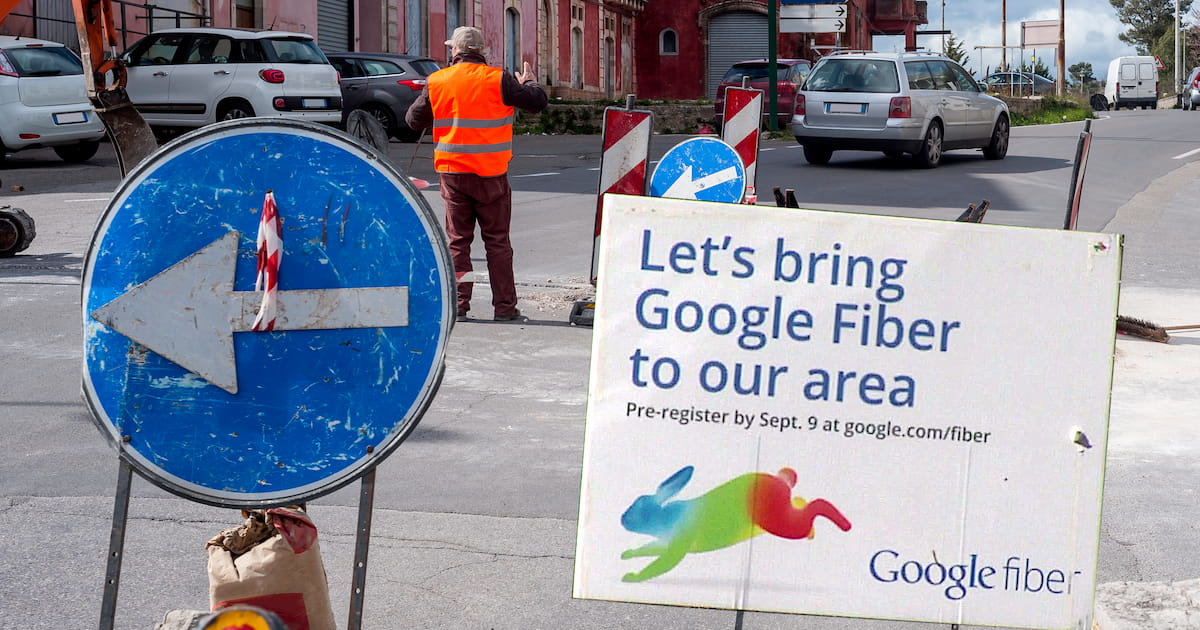DSL vs. Fiber Internet: Which One Is Right for You?
Oct 11, 2023 | Share
FAQ
-
Better for speed: Fiber
- Fast speeds
- Symmetrical uploads and downloads
- No data caps on most plans
- Limited availability
- Unnecessary multi-gig options
- Max speeds: 5,000 Mbps
- Price: $40.00–$300.00/mo.
-
Better availability: DSL
- Wide availability
- Easy installation
- No annual contracts on many plans
- Slow speeds
- High prices for slow speeds
- Max speeds: 100 Mbps
- Price: $39.99–$69.95/mo.
Data as of 10/11/23. Offers and availability may vary by location and are subject to change. Read disclaimers.
Would you rather drive a fuel-efficient SUV or a horse-drawn carriage? That’s the analogy that comes to mind when we think of the difference between fiber and DSL internet.
Fiber internet is state-of-the-art, ultra-reliable, and incredibly fast. It runs over fiber-optic cables that use the literal speed of light (or something close to it) to give internet access to your phone or laptop. On the other hand, DSL internet is old-school, kinda slow, and heading towards extinction. It’s built on the copper wiring of landline telephone networks that aren’t always in the best condition.
If you had to choose between fiber or DSL, naturally you should choose fiber—no doubt about it. DSL is only useful if you can’t get anything faster.
Need to know more about which connection type is right for you? Read on for a full breakdown of what makes fiber and DSL internet different and why fiber is the winning option for most netizens.
Find fast internet!
Want to get fiber or DSL internet at your house? Enter your zip code to see if it’s available in your area.
Top fiber internet providers
| Provider | Speeds | Price | Get connected |
|---|---|---|---|
| 1,000–8,000 Mbps | $70.00–$150.00/mo.*† | ||
| 300–2,048 Mbps | $49.99–$94.99/mo.**# | ||
| 300–5,000 Mbps | $55.00–$225.00/mo.‡ | ||
| 940 Mbps | $75.00/mo.§ | ||
|
| 500–5,000 Mbps | $39.99–$154.99/mo.║ | View Plans |
Data as of 10/11/23. Offers and availability may vary by location and are subject to change. Read disclaimers.
What is fiber internet?
Fiber is the fastest and best internet you can get. Fiber-optic cables consist of bundled strands of tiny glass or plastic, and a fiber internet provider sends photon signals through those strands to transmit data at near-light speed.
This is a newer technology than DSL, capable of delivering much faster speeds and requiring less upkeep. It also doesn’t experience the type of electromagnetic interference commonly found in DSL’s twisted-pair copper wiring, making for faster and more reliable service overall.
In fact, fiber is so reliable that telecommunications companies use fiber-optic cables to connect the major nodes of their global internet networks, spanning oceans and continents.
What makes fiber the right choice:
- Fast speeds capable of reaching up to 5,000 Mbps from major internet providers
- Symmetrical upload speeds which ensure a smooth connection during video calling and livestreaming
- Low latency to improve responsiveness in online gaming
How fast is fiber internet?
Fiber commonly delivers maximum speeds of 1,000 Mbps, but a range of speed options are available (from 100 Mbps all the way to 5,000 Mbps). It’s the only internet type that gives you symmetrical upload and download speeds, meaning uploads are just as fast as downloads. All of this gives fiber internet a very high capacity for activities like gaming, Zooming, and online streaming on multiple devices at the same time.
The only bummer about fiber is that it’s the rarest type of internet—available to only 42% of the US population, according to the latest data from the Federal Communications Commission (FCC).1 However, AT&T and other fiber internet providers have worked to expand nationwide access to high-speed fiber connections in recent months, so you may see fiber on your block soon enough.
The best fiber internet plans
| Plan | Speeds | Price | Get connected |
|---|---|---|---|
| Verizon Fios Internet 300/300 | 300 Mbps | $49.99/mo.† | |
| AT&T Internet 300 | 300 Mbps | $55.00/mo.** | |
| CenturyLink Fiber Gigabit Internet | 940 Mbps | $75.00/mo.‡ | |
| Google Fiber 1000 | 1,000 Mbps | $70.00/mo.§ | |
| EarthLink 1 Gig Internet | 1,000 Mbps | $89.95/mo.║ | View Plans |
Data as of 03/02/23. Offers and availability may vary by location and are subject to change.
Pro tip:
Take a speed test to figure out what kind of bandwidth you have on your home connection. Is it comparable to what you can get on fiber connections, or could you do better?
Top DSL internet providers
| Provider | Speeds | Price | Get connected |
|---|---|---|---|
| Up to 140 Mbps | $55.00/mo.* | ||

| Up to 80 Mbps | $49.95/mo.-$69.95/mo.*‡ | View Plans |
|
| Call provider for details** | $64.99/mo.§ | View Plans |
|
| Up to 100 Mbps | $39.99/mo.║ | View Plans |
Data as of 10/11/23. Offers and availability may vary by location and are subject to change. Read disclaimers.
What is DSL internet?
Digital subscriber line, or DSL, is a relatively outdated internet type but has a strong user base in rural areas and small towns with limited Wi-Fi options. It’s built on landline telephone infrastructure, using copper wiring to get you speeds of up to around 100 Mbps (although commonly less than that).
DSL is available in pretty much any home with a landline phone, and it’s way better than dial-up or satellite internet. That said, DSL seems to be gradually going the way of the dodo bird. Recent data from the Federal Communications Commission show that DSL availability has been going down, now available to just 57% of the U.S. population. That’s much lower than availability in previous years, but still 20% more accessible than fiber.
Providers like Verizon have been downplaying their DSL offerings to focus more on new tech like fiber and 5G. There haven’t been any advances in DSL technology in recent years, and prices on plans have pretty much stayed the same—even as fiber providers have introduced better options for equal or lower prices.
The best DSL internet plans
| Plan | Speeds | Price | Get connected |
|---|---|---|---|
| CenturyLink Simply Unlimited 140Mbps | Up to 140 Mbps | $55.00/mo.† | |
| EarthLink 80 Mbps Internet | Up to 80 Mbps | $69.95/mo.§ | View Plans |
| Kinetic Internet by Windstream up to 100 Mbps | Up to 100 Mbps | $39.99/mo.║ | View Plans |
Fiber vs. DSL—Speed comparison
| Connection type | Max download speed | Max upload speed | View providers |
|---|---|---|---|
| Fiber internet | 5,000 Mbps | 5,000 Mbps | View Fiber Providers |
| DSL internet | 140 Mbps | 10 Mbps | View DSL Providers |
Fiber is a lot faster than DSL. Most fiber providers have plans capable of hitting 1,000 Mbps (gigabit) speeds—ten times faster than the absolute max speeds of DSL. Some fiber providers offer speeds of up to 2,000 Mbps or even 5,000 Mbps. By comparison, DSL in some areas will top out at just 25–30 Mbps due to technical and infrastructure limitations.
Fiber has faster upload speeds
While download speed is the most common benchmark for measuring internet bandwidth, you should also consider upload speeds when comparing these two types. Like cable, satellite, and most other internet connection types, DSL internet delivers relatively slow uploads even when it has the capacity for fast downloads.
On the other hand, fiber internet packages give you “symmetrical” uploads and downloads—meaning upload speeds will be just as fast as gigabit downloads. Symmetrical speeds make fiber internet particularly effective for Zoom calls, content creation, and posting to social media, all of which are tasks that require a stable upload throughput.
Fiber has better latency
Latency is the brief window of time it takes for a signal to be processed when you’re communicating from your device with a central network—such as when you hit send on an email or hit a trigger on a gaming controller.
Some latency is inevitable in any kind of internet network, but lower latency is always better, and fiber has much lower latency rates compared to DSL. It uses fiber-optic cabling, which can transfer data more quickly and efficiently than the copper of DSL.
Low latency makes fiber the best option for activities like fast-paced online gaming, in which you need near-instantaneous connectivity for smoother gameplay.
What you get with low latency:
- Quick reaction times in online gaming
- Smooth connection over livestreams
- Stable video and audio feeds on Zoom
DSL has much higher latency rates because it relies on copper wiring (which is often older), is susceptible to electromagnetic interference, and experiences increased rates of signal deterioration over longer distances.
What you get with high latency:
- Laggy connection over Zoom
- Delays between audio and video feeds on video calls
- Chunky movements and poor response times in gaming
Fiber vs. DSL—Price comparison
Fiber is the better-priced option of these two internet types, giving you faster speeds for an equal or even lower price than DSL.
It used to be that if you wanted fiber internet, you’d have to pay a premium for a gigabit internet plan. But these days you can get fiber plans for as low as $30 a month, featuring speeds that aren’t quite gigabit but that are still very fast. Meanwhile, many DSL plans cost upwards of $45 to $50 a month, even though they have slower speeds and fewer added perks.
A DSL plan will still be cheaper than gigabit fiber, which usually costs upwards of $70 to $100 a month. But DSL can’t beat the value of an entry-level fiber plan, which gives you much better service at a lower price.
Fiber vs. DSL—Setup and equipment comparison
| Connection type | What is needed for installation | Installation costs |
|---|---|---|
| Fiber internet | Optical network terminal, fiber-optic cabling from home to curb | $49–$85; free for self-installation |
| DSL internet | Telephone wiring, telephone jack in home | $35–$85; free for self-installation (in most cases) |
DSL is generally easier than fiber to install, since it works over telephone wiring that’s common in most homes and apartment buildings. So long as you have that wiring in your home, you can opt for self-installation with a DSL provider, which saves you on expensive installation fees.
Fiber-optic internet requires an optical network terminal to operate, which isn’t commonly available in many homes (especially older ones). Some fiber connections also require professional installation to complete the “last mile” of the network, meaning the connection from the curb or apartment building directly into your home. So you may end up having to pay higher installation costs for a fiber hookup.
| Connection type | What equipment do you need? |
|---|---|
| Fiber internet | Wi-Fi router, Ethernet cable |
| DSL internet | DSL modem and Wi-Fi router, telephone cable, Ethernet cable |
As for equipment, both DSL and fiber require a router to get your Wi-Fi flowing. You can rent a router from your provider for $10–$15 a month depending on your package. Another option: buy your own router, which we think is a much better idea.
Pro tip: Buy your own router to save money
Buying a router (as opposed to renting one) saves you money in the long run and lets you be more choosy about things like security features, parental controls, and the router’s Wi-Fi standard.
Need a router rec? Take a gander at the best routers for streaming and the best long-range routers. Or just put in an order for the Google Nest Wi-Fi mesh router (the best router for your bucks).
Fiber vs. DSL—Availability comparison
| Connection type | Availability (to % of US population)* | Get connected |
|---|---|---|
| Fiber internet | 42% | View Providers |
| DSL internet | 88% | View Providers |
*Data from the Federal Communications Commission.
Since DSL relies on landline telephone wiring, DSL connections are easy to access in a wide majority of American homes, especially older ones where a phone line was installed when the home was built.
Fiber, by comparison, is a lot less widely available—mostly because internet providers have dragged their feet in laying the fiber-optic cable on a large enough scale to expand fiber networks.
Some fiber-optic internet providers have been working to build up fiber access nationwide. If you want fiber internet in your area, consider attending community meetings with your local elected officials to rally for increased fiber access. Fiber providers often reach out to the community to measure interest, and some cities and towns have built up municipal fiber networks of their own.
Tap in your zip code to see if there’s fiber or DSL internet near you.
Other types of internet and how they compare
Comparing fiber internet with DSL is a bit like comparing an elegant white swan with a common street pigeon—they’re quite different, and there are a lot of other options in between. Here’s a gander at other common internet connection types.
Cable internet
Cable internet is cost-effective, widely available, and fast. Running over the coaxial copper wiring of a cable company, it’s the next best thing after fiber-optic internet. Cable gives you reliable speeds (including gigabit capability) at a fair price.
You won’t be able to get the same upload speeds as with fiber. You’ll likely also experience internet slowdowns during peak use hours. But all in all, it works well.
4G LTE and 5G home internet
4G LTE home internet and 5G home internet is the new hipster internet for cord cutters and early tech adopters. It uses wireless signals from nearby 4G and 5G cellular towers to get you a Wi-Fi connection over a router installed in your home.
Availability is limited, and a wireless internet connection’s performance can depend on factors outside your control—like bad weather and geographic obstructions that impede a cell signal. But these services are affordable and usually come with some enviable perks (such as flat rates, unlimited data, and no annual contracts). The speeds are good too, ranging from 100 Mbps to 1,000 Mbps depending on the provider.
Fixed wireless internet
Fixed wireless internet is very similar to 4G LTE and 5G home internet, since it also uses wireless signals to get you a connection. But an internet connection that’s advertised as “fixed wireless” (as opposed to 5G or 4G internet) is generally tailored for rural customers who live in remote areas with few other Wi-Fi options. It’s the best alternative to satellite internet, with speeds similar to DSL and relatively manageable pricing.
Satellite internet
Satellite internet is available in even the most rural places and forbidding landscapes, since the signal beams down from space. But satellite has slow speeds, high prices, and onerous data caps. You should get satellite internet only if there are no other internet connection types available in your area.
Pros and cons: DSL vs. fiber
DSL internet
 Pros:
Pros:
- Cheap prices
- Flexible monthly contracts
- Straightforward options
 Cons:
Cons:
- Slow speeds
- Weak connections over long distances
Fiber internet
 Pros:
Pros:
- Record-breaking speeds
- Reliable connections
- Low latency
 Cons:
Cons:
- Expensive prices
- Limited availability in many areas
Verdict—Fiber is better than DSL in almost every way
If you can get fiber internet, definitely get it. Fiber is way faster, more reliable, and sometimes actually more affordable than DSL. It’s harder to come by and may deliver more bandwidth firepower than some users need, but it’s the best out there.
DSL runs at much slower speeds than fiber, but it’s still fast enough for a lot of what you’ll want to do online. It’s available practically anywhere, making it ideal for the average user. The price isn’t always the best for the speeds you get, but it’ll work in a pinch—and it’s still way better than satellite or dial-up.
FAQ about fiber vs. DSL internet
Is cable internet better than fiber-optic internet?
Cable internet is slightly slower and sometimes more expensive than fiber-optic internet, so it’s not exactly better. Also, cable internet doesn’t have symmetrical speeds like fiber does. But it is more widely available than fiber internet and also sometimes comes at budget prices you can’t get from fiber. So it’s still a great internet option if you want fast speeds and reliable service.
Is cable internet better than DSL internet?
Cable internet is a lot faster than DSL internet—as much as 10 times faster in some cases. It gives you better speeds for the money and is just as widely available as DSL, so we’d say it is definitely a better option than DSL internet.
More resources on fiber vs. DSL internet
Disclaimers
Top fiber internet providers (return to top)
*Terms and Conditions: Plus taxes and fees. Service not available in all areas. If you live in an apartment or condo, Google Fiber’s ability to construct and provide Fiber is subject to the continued agreement between Google Fiber and the property owner. Upload/download speed and device streaming claims are based on maximum wired speeds. Actual Internet speeds are not guaranteed and may vary based on factors such as hardware and software limitations, latency, packet loss, etc.
†Available in select markets only. Plus taxes and fees. Upload/download speed and device streaming claims are based on maximum wired speeds. Actual Internet speeds are not guaranteed and may vary based on factors such as hardware and software limitations, latency, packet loss, etc.
**w/ Auto Pay. Available in select areas.
#w/ Auto Pay and select 5G mobile plans. Available in select areas.
‡Price after $5/mo Autopay & Paperless bill discount (w/in 2 bills). Plus taxes & fees. Monthly State Cost Recovery Charge in TX, OH, NV applies. One time install chrg may apply. Ltd. avail/areas. Call or go to www.fiber.att.com to see if you qualify.
§Speed may not be available in your area. Maximum download/upload speed of up to 940 Mbps via a wired connection. Paperless billing required. Taxes and fees apply. Offer details. Offer includes professional installation at customer’s eligible location.
║w/ Auto Pay & Paperless Bill. Max wired speed 1000/1000 Mbps. Location dependent. Wi-Fi, actual & average speeds vary. One-time charges apply.
The best fiber internet plans (return to top)
*Speed may not be available in your area. Paperless billing required. Taxes and fees apply. Offer Details. Online ONLY. Free Modem.
**Price after $5/mo Autopay & Paperless bill discount (w/in 2 bills). Plus taxes & fees. Monthly State Cost Recovery Charge in TX, OH, NV applies. One time install chrg may apply. Ltd. avail/areas. Call or go to www.fiber.att.com to see if you qualify.
†w/ Auto Pay. Available in select areas.
‡Rate requires paperless billing. Additional taxes, fees, and surcharges apply. Speeds may not be available in your area. Maximum download/upload speed of up to 940 Mbps via a wired connection.
§Terms and Conditions: Plus taxes and fees. Service not available in all areas. If you live in an apartment or condo, Google Fiber’s ability to construct and provide Fiber is subject to the continued agreement between Google Fiber and the property owner. Upload/download speed and device streaming claims are based on maximum wired speeds. Actual Internet speeds are not guaranteed and may vary based on factors such as hardware and software limitations, latency, packet loss, etc.
║w/ Auto Pay & Paperless Bill. Max wired speed 1000/1000 Mbps. Location dependent. Wi-Fi, actual & average speeds vary. One-time charges apply.
You can get gigabit speeds over a fiber plan so long as you’re willing to pay a premium price for fiber internet. That will give you all the firepower you need to do pretty much anything online with lots of devices at the same time.
But you’ll still get excellent speeds if you choose a more budget-friendly option. A speed of 300 Mbps will be enough to support streaming 4K video, online gaming, Zoom calls, and a lot of other activities on several devices at once.
Top DSL internet providers (return to top)
*Paperless billing or prepay required. Additional taxes, fees, and surcharges apply. Get the fastest internet speed available at your location (max speed is up to 100 Mbps).
†for 12 mos, plus taxes & equip. fee. Autopay & Paperless Bill req’d. $10/mo equip. fee applies
‡with a 12 month contract.
§ w/ Auto Pay and Paperless bill per month for 24 mos. One-time charge on disconnect applies. In select areas where available.
║For the first 12 months. No data caps. No overage charges. 30 day money back guarantee.
The best DSL internet plans
†Paperless billing or prepay required. Additional taxes, fees, and surcharges apply. Get the fastest internet speed available at your location (max speed is up to 100 Mbps).
‡Plus taxes. Price after $5/mo Autopay & Paperless bill discount (w/in 2 bills). Monthly State Cost Recovery Charge in TX, OH, NV applies.
§with a 12 month contract.
║For the first 12 months. No data caps. No overage charges. 30 day money back guarantee.
Most DSL plans work on a flat-fee basis—you pay a set price for whatever speeds are available in your area. Some providers can deliver max speeds of up to 140 Mbps, but realistically speaking, you’re more likely to get speeds in the range of 10–40 Mbps. Expect a slower connection in rural areas and city outskirts as you get farther away from the provider’s central server.
Author - Peter Holslin
Peter Holslin has more than a decade of experience working as a writer and freelance journalist. He graduated with a BA in liberal arts and journalism from New York City’s The New School University in 2008 and went on to contribute to publications like Rolling Stone, VICE, BuzzFeed, and countless others. At HighSpeedInternet.com, he focuses on covering 5G, nerding out about frequency bands and virtual RAN, and producing reviews on emerging services like 5G home internet. He also writes about internet providers and packages, hotspots, VPNs, and Wi-Fi troubleshooting.
Editor - Rebecca Lee Armstrong
Rebecca Lee Armstrong has more than six years of experience writing about tech and the internet, with a specialty in hands-on testing. She started writing tech product and service reviews while finishing her BFA in creative writing at the University of Evansville and has found her niche writing about home networking, routers, and internet access at HighSpeedInternet.com. Her work has also been featured on Top Ten Reviews, MacSources, Windows Central, Android Central, Best Company, TechnoFAQ, and iMore.




